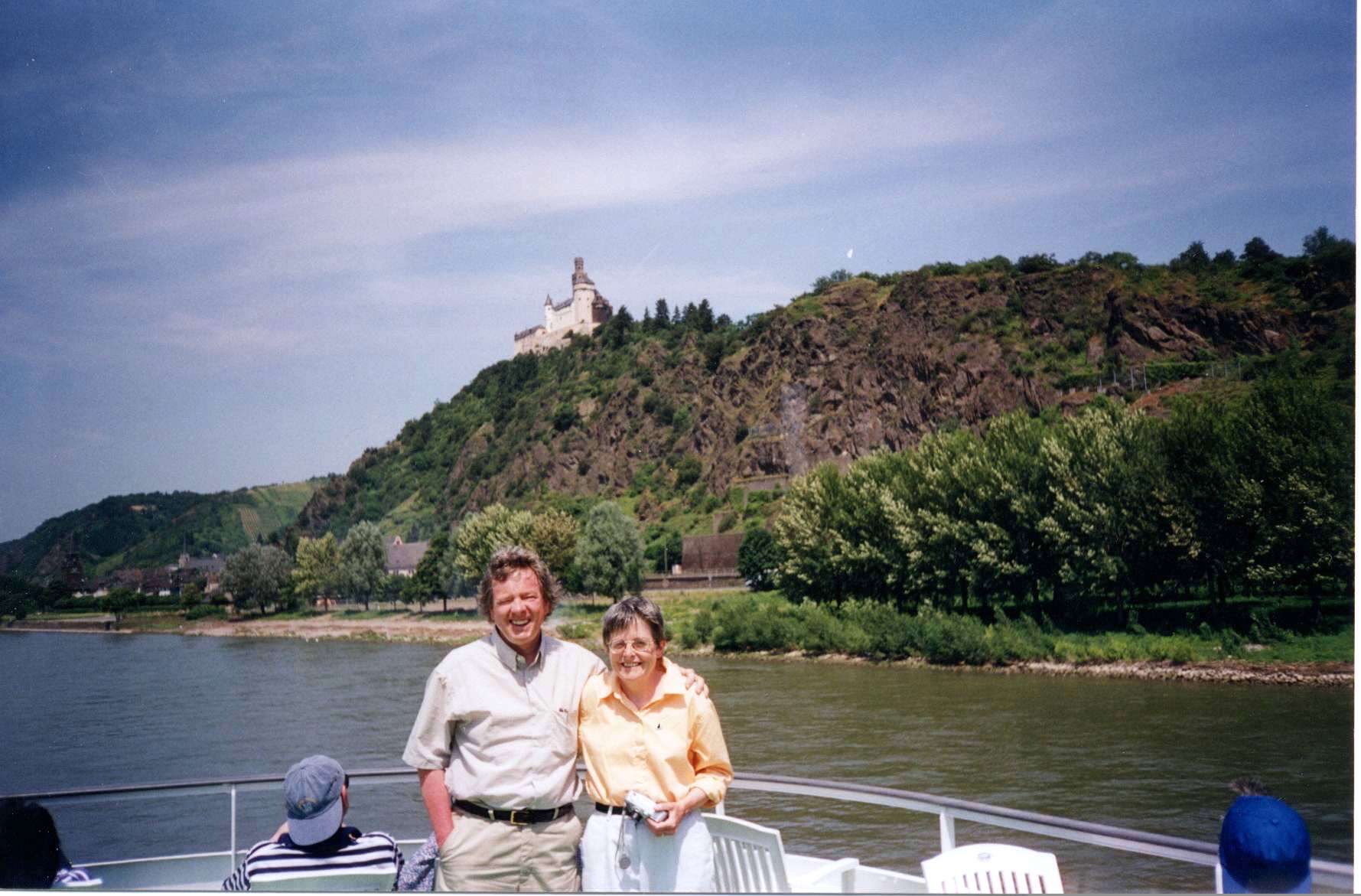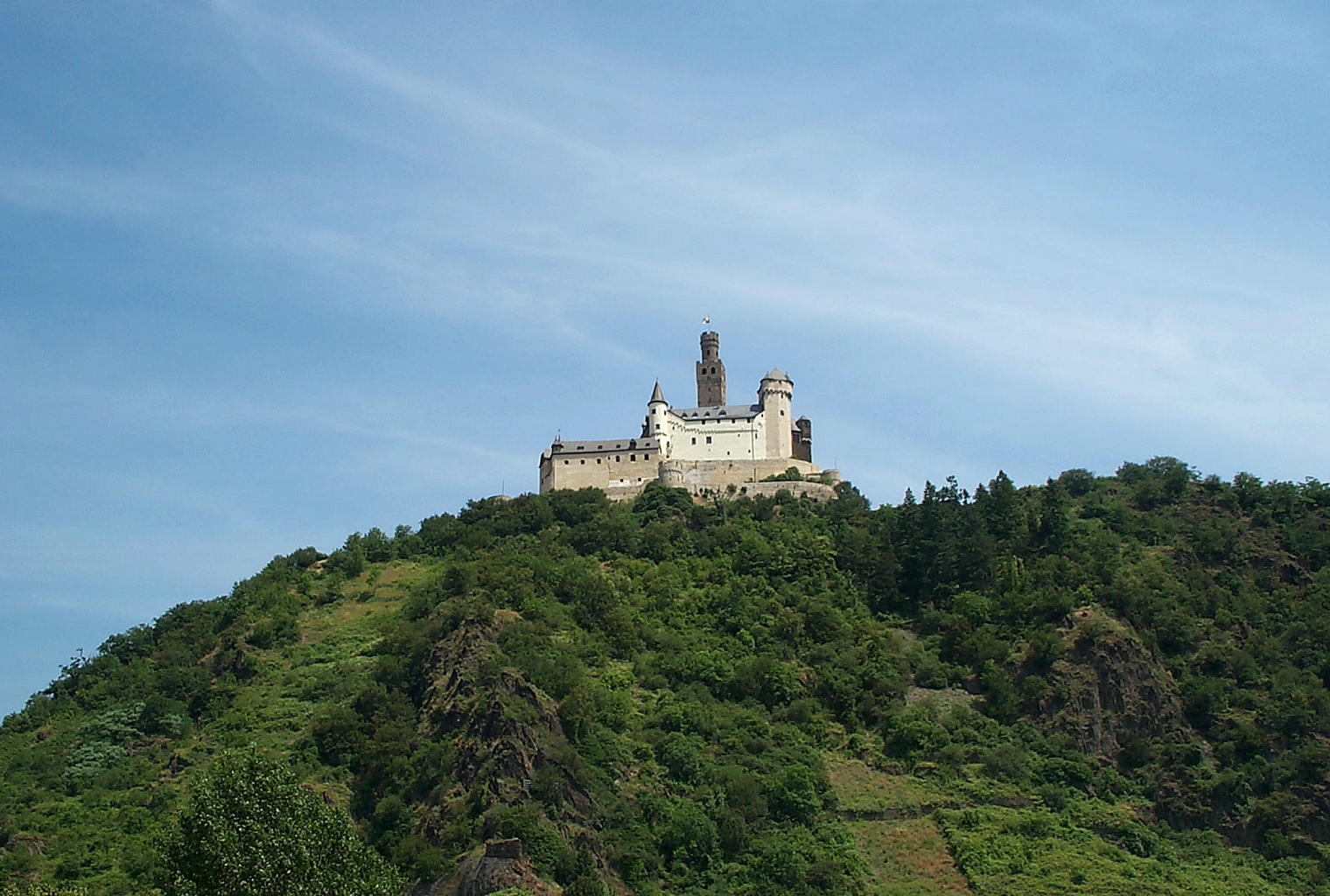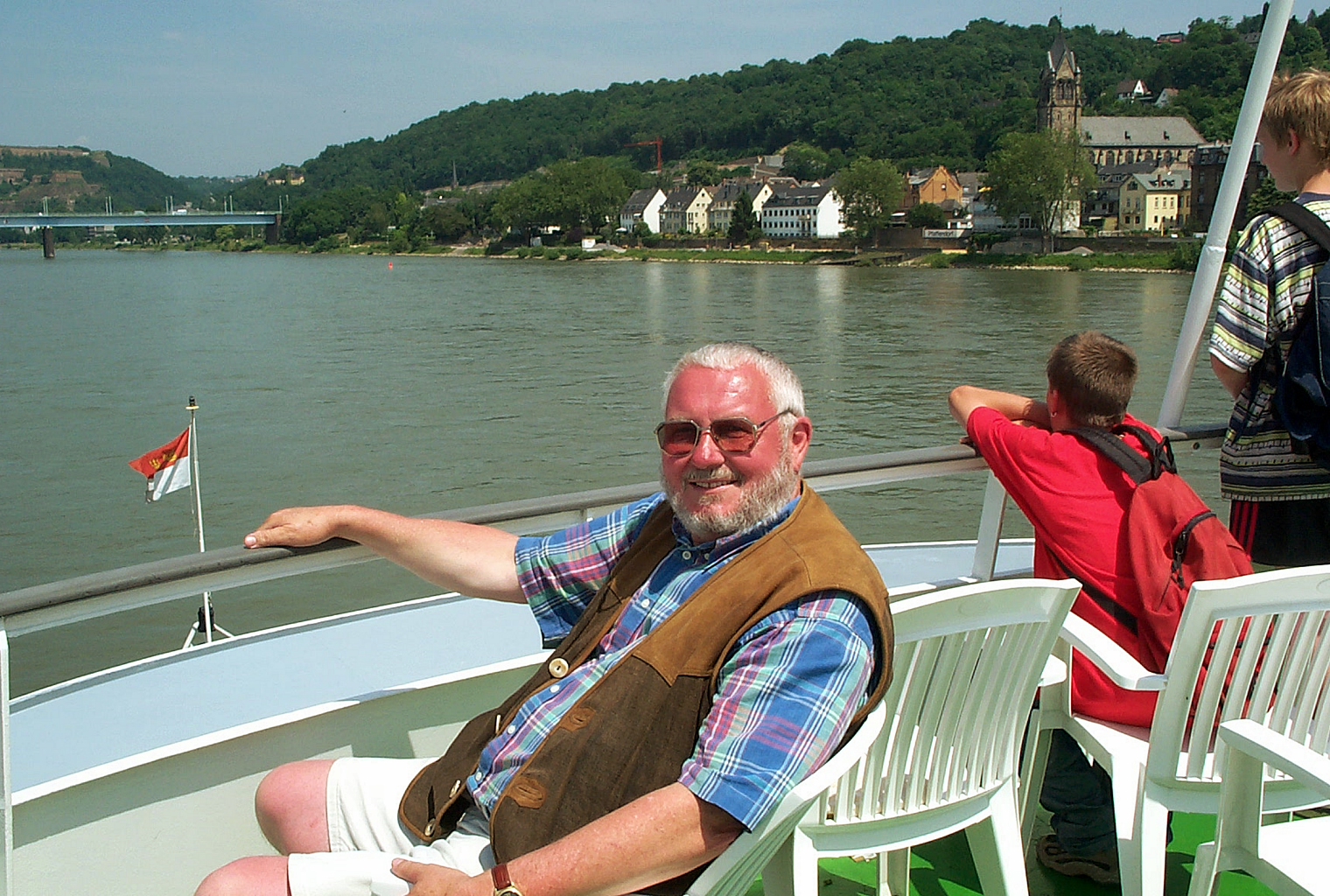
I call it the Marksburg photo, even though Marksburg, the castle on the mountain behind the two of us, is almost unnoticeable. I once mounted a section of the picture on a small magnet on our refrigerator door, as a reminder of our travels along the Rhine before they grew too distant in memory. The two of us are on the magnet, with glimpses of green water and greener trees behind us and the white walls of the castle high above us. No one who sees it can guess where we were; sometimes I almost forget. In the 17 years since the photograph was taken, my hair is no longer so curly, we both have white hair now, but I still have that shirt. Our image captures that moment—the cheeriness, the closeness, the pleasure in being who we are and where we are. None of that has changed between then and now. When I found the entire Marksburg photo again, I looked at the two of us and smiled to have the moment between us recorded so well.
It took me a while to ponder what more was in the photo, not about us but about where we were and what we were doing there. Another photo taken a little further downriver, using the telephoto feature on my camera, places the Marksburg at the center of the image, rising above a round green landscape of trees and fields, poking into a broad expanse of clear blue sky. Holding the photos side by side I struggle to unearth whatever Rhine memories I can. Soon I’m revisiting old obsessions and, unexpectedly, unveiling new interpretations.
* * *
I’d been writing about place on a small scale, in short essays for local radio, before our first excursion together to the Southwest. The Anasazi ruins of Mesa Verde and Chaco Canyon haunted me for years after. It altered my writing, made me focus more intently on place; it sent me to unfamiliar terrains hoping to somehow connect across time with earlier authors who’d written about such places. Before we set off to any new destination I would read travel narratives and nature memoirs set there; if something spoke to me about the locale while we were there, I longed to write about it. Research projects I proposed to my university became essentially, if not overtly, about time and timelessness in place—if I went to where a writer had recorded an immersion in place, I wondered, what would I encounter there that that writer encountered? What would have changed beyond recognition? What was timebound, what timeless? Travels to Thoreau’s Walden Pond and E. B. White’s Belgrade Lakes took on the character of pilgrimages; other locations—London, Paris, Rome—seemed like nice places to visit but I didn’t want to write about them.
And then I chanced upon George William Curtis’s Lotus-Eating: A Summer Book. It opens with two chapters comparing the Hudson and the Rhine before visiting tourist sites in New York and New England. Somehow I began tracking down nineteenth-century writers who had written anything about either of those rivers, or better yet, compared them: James Fenimore Cooper, Victor Hugo, Washington Irving, Caroline Kirkland, Harriet Martineau, Herman Melville, Catherine Sedgwick, Bayard Taylor, Mark Twain, Nathaniel Parker Willis, William Wordsworth, among others. I also read travel guides and memoirs by my contemporaries. The literary scholar in me might well have launched himself into an academic monograph about the literature of the Hudson and the Rhine if the travel memoirist in me hadn’t insisted he had to see the rivers for himself—needed to stand where earlier writers stood, walk where they walked, sail past the landscapes they viewed.
My eventual sabbatical project centered on time and timelessness by following the Rhine River from its origins in the Alps through Switzerland, Germany, and the Netherlands to its dispersal into the North Sea. I would view its landmarks, its landscape, its most significant features, take in its cathedrals and castles and spas, tour sites of literature and art and history. And I would cruise the Rhine.
Even today, nearly two decades after that cruise, one of my bookshelves is still filled with books I read about the Hudson and the Rhine in preparation for my travels and in anticipation of the book I would write. My daily logbook and my project journal are on the same shelf. In an envelope in a file box in the study closet are ninety-four photos from the Rhine journey, thirty-six of them taken on that cruise. Years ago I typed up the log and journal entries and occasionally transferred the files from computer to laptop to CD to flashdrive in unreflective anticipation of—eventually—composing that travel book.
And now, after reading, rereading, and yet again rereading the entries, after leafing through the images, all lacking identifying notes, I hope at least to say more about that Marksburg photo, the cropped image still on our refrigerator door reminding me daily to go back upstairs and revisit the Rhine.
* * *
I take photographs in hopes of later spiking bursts of memory. Often I record trailhead signs before sites along the trail, expecting to march from one location to the next by viewing an internal slideshow of snapshots in the order I took them. If I review the images not long after the physical event, I can more vividly imbed the experience in memory. The longer the gap between being in that place and contemplating the piecemeal record on film, the more difficult it becomes to make the connection.
And so when I isolate the Rhine cruise images from the pile of photographs, I have little certainty about what they record. I handle them carefully, confident that they are arranged in the order they were taken as we sailed from Mainz to Koblenz and aware that, if I dropped them, I’d be unlikely to find the correct sequence again. Only the river in the foreground of most shots confirms that they were taken from the Köln-Dusseldorfer Line cruiseship where we sat on the uppermost deck, at the bow of the vessel, in warm sun and light wind. Other passengers surrounded us, a continual hubbub, many crowding the rail taking pictures. My images mostly center on aspects of landscape between the blue of the June sky and the blue-green of the river. I hold up one early photo and scan the buildings lining the shore—some likely domestic, some probably industrial, a pair of church towers off to one side, a dark spiked dome off to the other. Nothing in the picture reveals why I took it. All the images record what we were passing, but I’m uncertain about what they record.
I examine the photographs one at a time. They often highlight castles on hillsides or against the skyline—surely the reason for taking them. I don’t recall if anyone narrated the cruise, calling attention to specific ruins or renovations or identifying the waterfronts where we frequently docked to gather more passengers. My log reminds me that each time we departed, the ship’s loudspeakers played the opening of Schumann’s 3rd Symphony, the “Rhenish,” reminding us all that we were sailing out onto the “Romantic Rhine.” I’d played it often at home, along with Smetana’s Die Moldau, evocative river music. The memory makes me briefly optimistic that playing the recording again might spark more memories.
Attempting a more systematic, more academic approach, I compare the names of locations recorded in my logbook with locations on a map of the Middle Rhine and search through a compendious Rhine book and Wikipedia sites. By comparing a picture of my own with images in the book or on my computer screen, I slowly learn what I photographed. I record names and locations on the back of each picture and list the sites in the order we passed them on the river. I tinker with Google maps on my laptop to gain a better appreciation of the course of the Rhine, its twists and turns, its bends and straightaways, expanding my sense of where each site is located along the river.
I’d wondered what was timebound and what was timeless along the Rhine. Photo after photo captured a distant view of castle ruins or a castle converted to hotel and restaurant, castles perched on hillsides, castles dominating the summits above the river: Ehrenfels, Rheinstein, Reichenstein, Sooneck, Fürstenberg, Pfalzgrafenstein (this one on an island), Gutenfels, Rheinfels, Katz, Marksburg, Stolzenfels—still standing after five hundred, seven hundred, a thousand years, each a persistent presence along the Rhine. Two of my photos show a dark rocky promontory dominating a bend in the river, the Loreley, site of literary legend; a little further on, a bronze statue of the nude siren herself sits on a narrow strip of land extending into the river. The statue in my photo of the site is so remote and small that at first I didn’t realize it was what the picture centered on. Once I identify both promontory and statue, I remember that beyond the scope of our cruise, further north, we visited the Drachenfels (Dragon’s Rock) in the Siebenbirge (Seven Mountains), the supposed site of Siegfried’s battle with a dragon in the medieval epic Das Nibelungenlied; music from Wagner’s Ring of the Nibelung opera cycle would greet us there just as Schumann’s Rhenish repeatedly celebrated our being on the Rhine. My photos capture nothing of the artistic history that abounds here, and I recall no observations by any of those nineteenth-century writers I’d read.
Somehow I’d remembered that it was the Marksburg Castle behind us in the distance in that photo of the two of us and I was pleased with myself when I recognized it in a photo of its own. Unlike so many other castles and castle ruins, it doesn’t blend in with the scenery but dominates the hillside and the river, bright white against green woods and terraces. In its 900 year history it was never attacked, never embattled, continually restored and remodeled. The little research I do concerning it makes me think of it as merely picturesque, a fine element for the backdrop of a tourist picture.

* * *
The photo of Marksburg is the kind of picture I usually take, informative, impersonal, a static record of a moment in place. The photo of Sue and me was taken by another passenger, a German with whom we’d been conversing about the Rhine. He said that we could see signs of historic high water where narrower sections of the river are wedged in by mountain ranges; he pointed out how the first floors of buildings along the river had small round windows and lower story garages and sheds in preparation for flooding; he thought Bacharach was the prettiest Rhine town, with Oberwessel second, Boppard third. We learned he’d begun learning English as a boy, taught by American soldiers occupying his hometown after the war. They would give him snack food, candy and gum sent to them from the United States, and they would teach him American expressions. They were kind to him, he said, and often funny; he liked Americans. I photographed him sitting in the plastic chair on the foredeck, the Rhine immediately behind him, the shoreline in the distance, in part because I didn’t want to forget him and in part because what he said about his childhood began altering my perception of where we were.

The cheerful, sun-burned German smiling at us in the photograph must have been a few years older than me. His conversation, light and pleasant though it was, triggered in me a growing awareness that what we were seeing along the Rhine and what we would end up seeing throughout Germany were remnants of a very different century than all those travel narratives and memoirs I’d read had encouraged me to imagine. Two World Wars were centered here—massive destruction, massive annihilation, grim and terrible aspects of life that neither my wife nor I had experienced. Later I would sometimes wonder if one of the GIs so kind to that German boy had been my father-in-law—he had served throughout the course of the war, from North Africa and Italy through the Normandy D-Day landing and the Battle of the Bulge and the liberation of Bergen-Belsen, experiences that haunted him for fifty years, to the end of his life. The German had not only childhood memories of the war but also those of the second half of the 20th Century—the rebuilding of West Germany; the Soviet occupation of East Germany; decades of political disruption before the reunification of the country he was born into. I know almost nothing about him or his life, except that he was genial and conversational and remembered with fondness experiencing the kindness of American soldiers, learning the rudiments of the English language as they spoke it, feeling safe in the midst of occupying troops. What did the artifacts of die Mittel Rhein mean to him, all those castles and cathedrals and villages and vineyards? What did he think of the foreign tourists—American, Indian, Asian, Middle Eastern—idly curious about the scenery, casually taking pictures of his homeland? Did he share our sense of easy accommodation, our sense of security, our sense of privilege?
And what did meeting him mean to me? In the days that followed I became more conscious of what was missing and what had been reconstructed and what the generation after the war tried to replicate exactly, as if the war had never happened here. In the souvenir stands the postcards of the magnificent cathedrals or the historic castles celebrated their glories but always shared space with those that recorded the demolition and destruction during the war. It was as if the population refused to forget, refused to allow themselves psychic space to dwell simply on the present, and as a consequence we cheerful tourists were constantly reminded of what came before and had to look aside if we hoped to avoid being reminded. And I would think of the wartime stories my father-in-law sometimes told his children and the wartime stories my own father, veteran of Saipan and Iwo Jima, refused to tell any of us. As we continued our wanderings I often struggled to keep focused on the sites those nineteenth-century writers recorded seeing, keep wondering how much I could appreciate the way the Rhine reminded them of the Hudson or how much being where they had been would make me feel as if I were with them then instead being here now. Given all that had happened here, was anything timeless really left? The river kept flowing, rising and falling in the sequence of seasons, and the Taunus Range on the right bank and the Hunsrück Range on the left bank still hemmed it in. But what did those castles and cathedrals and fortresses, those ruins and remnants and restorations, mean to the people who still had lives to live in the terrain around them? They were doing their best to live as much in the moment as they could, occupy their own span of time, neither timebound nor timeless, simply immediately present.
I don’t remember now if we asked the German to take our picture or if he volunteered of his own accord. Looking now at the picture he took I realize that he chose to include the Marksburg, lined the American couple on the cruiseship up with the castle on the mountain. A courtesy, a gift, connecting two visitors with a landmark of his country. I want to think it’s what he intended. Otherwise, only the moments frozen in the photographs tell us anything about where we were and how we felt about being there. Timebound images. Good ones to have.